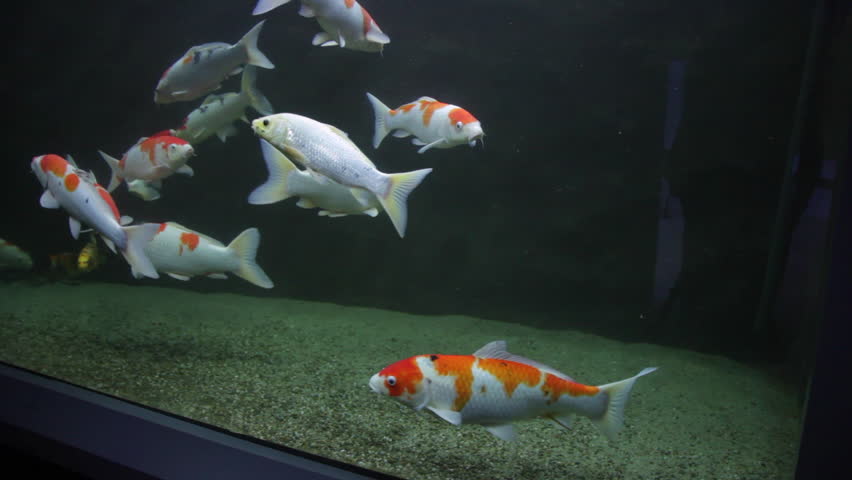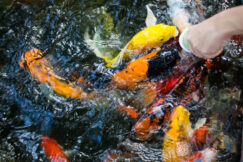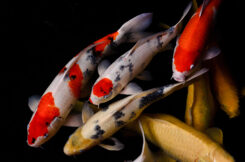Koi are available in a wide range of breeds, with mature size and density preferences. Although they are thought to be very adaptive, their fundamental needs must be satisfied to attain the necessary growth and survival rates.
They aren’t for everyone as beautiful as a well-designed koi pond might be. Even those with a koi pond may question if their koi fish can survive the winter in a tank.
Is it possible to keep Koi fish in a tank?
The short answer is that koi fish may survive in a fish tank or aquarium indoors. But, as with any other fish, they will be alright if their fundamental needs are addressed.
Koi develop swiftly and can reach enormous sizes. Keep adult koi in a 3-foot-deep outdoor pond with at least 50 gallons of water per fish. Young Koi can be housed inside an aquarium with at least 29 gallons capacity.
What are these fundamental considerations? A correctly sized koi tank, temperature management, water filtration, water changes, and regular feeding are among them.
There are several benefits to maintaining Koi in a tank instead of a pond. First, they are visually appealing and may serve as the main point of any space or office. In a tank, you may enjoy them all year round, regardless of the weather.
Many individuals who own koi ponds choose to keep them indoors throughout the winter. This makes monitoring their health easy, and they will continue to thrive during the typically inactive winter season.
Koi Fish Facts You Should Know
Koi are gentle fish that may form groups of 5 to 15 fish. These groups will swim unison and appear attractive in a pond or aquarium. Unlike other fish who like to stay on one level, koi fish move quickly and visit every level of your aquarium.
Sometimes you’ll see them at the surface, and other times you’ll see them at the bottom. For example, Koi fish will most likely swim at the bottom when the water is exceptionally cold.
Because koi fish are incredibly active and do not tire quickly, you can anticipate them swimming in your aquarium at all-day hours. When searching for food, koi fish can dig into the mud and consume seeds, occasionally damaging your aquatic vegetation. They feed like a vacuum because they swallow the food in large gulps, which aids in the filtering of dust and filth.
Koi fish may grow 3 feet long, making them far bigger than ordinary tank fish. They have barbells on both sides of their faces, no teeth to aid in gulping food, and a spherical snout.
Female koi fish are larger than male koi fish and have more circular bodies. Koi fish are often silver or white with brilliant patterns and dots that make them stand out in a pond or aquarium.
Why Can’t We Keep Koi in a Tank?
Koi are quite huge fish. They need a lot of room to roam about and are often highly active.
As a result, they cannot be kept in a confined cage like a fish tank. There is a common misconception that a fish would only grow to the size of its tank.
A koi fish may readily grow to be more than three feet long.
This implies that it is stunted when a koi fish is maintained in a tank and cannot reach its full size.
A koi that does not have enough space to grow is cruel and can have major health consequences.
While the answer to the question “can koi fish survive in a fish tank?” is technically correct, it is not a good idea or appropriate care practice.
Koi fish housed in pet store aquariums are often relatively tiny, and the tanks are frequently overstocked.
They are purchased fast and removed from the crowded tank quickly enough that it does not usually have a long-term negative influence on their health.
If you intend to maintain Koi in a tank, it must be large enough to accommodate all of your fish.
If you have several fish, ten gallons per inch of each fish.
As you might see, this will rapidly become a large volume of tank demand.
The size of a koi
Koi come in various sizes and hues and a wide range of colors. Therefore, to calculate the tank size, you must first assess your Koi size.
Koi occur in a variety of sizes, the most common of which are:
Japanese Koi are 12-15 inches long. Jumbo koi: 22-26 inches long 34-36 inch long Koi
Even the lesser varieties of Koi may live for a long time as farmed fish. Regardless of the tank size, Koi will grow to their genetic length. Therefore, keeping in a smaller tank will only lengthen the time it takes your Koi to reach their maximum length.
Do Koi fish grow to the size of their aquarium?
There is some truth to this, but it is not as harmless as it seems and has more to do with water quality than koi fish tank size.
Koi fish will continue to develop if properly cared for. The majority of fish are what are known as indeterminate growers. This implies that, unlike humans, they continue to develop until death.
Their growth rate will be slower when they are approximately 3 years old than when they are 0 to 1 years old.
Minimum Tank Size for Koi Fish
When keeping Koi in a fish tank or a koi pond, space is key.
The koi fish’s huge size is one of its most notable characteristics. Therefore, when choosing a fish tank, this must be considered.
A well-cared-for koi fish may grow 24 inches long, with the biggest reaching a whopping 36 inches! Even common household koi may grow to be over a foot long. This is far more than the vast majority of home aquarium fish.
How much water does a koi fish require?
We recommend two rules of thumb for the quantity of Koi in a pond or koi fish tank.
Typically water conditions allow 1 inch of fish per 10 gallons of water.
This implies that a single 12-inch koi would require 120 gallons of water! As you can see, a big tank is required for only a few full-size Koi. This method does not even account for the huge girth of koi fish.
Size of Koi Tank Recommendation
- 50–100 gallons for Small Koi 2′′–8′′
- 100 – 200 gallons for Medium Koi 8′′ – 14′′
- 200–500 gallons for Large Koi 14′′–24′′
- 500–900 gallons for Jumbo Koi 24′′–36′′
However, some individuals have successfully kept many more Koi than this. Remember that you will want excellent filtration and frequent water changes. Your Koi’s development will most likely be slowed as well.
You must have a strategy in place for when they outgrow their tank. If a pond isn’t a possibility at this time, local koi clubs are a fantastic choice for rehoming your Koi.
Set the Optimal Temperature and pH Levels
Koi fish thrive in tropical and frigid conditions, although they prefer water temperatures over 70 degrees Fahrenheit. Add a heater to your fish tank during winter, or your koi fish may freeze.
Like other aquatic species, koi fish do not require water flow to float in the tank. Maintain the pH of your fish tank between 7 and 9. You may always break limestone and add it to your fish tank to maintain the pH stable.
Setup of a Koi Tank
The following goods will assist you in your quest to set up an aquarium. None of this is unique to Koi, and the key modification to fish farming is the number of Koi in the tank. These are often used products for aquarium management.
- Tank: Koi grow in proportion to the size of the aquarium. Choose the aquarium based on the size of the Koi and the location.
- Cover: An aquarium cover keeps Koi from jumping out and evaporation at bay.
- Aquarium stand: A full aquarium is hefty, so be sure your aquarium stand can support it. Make sure to place your bulky tank on a firm surface that won’t be pushed over by passing dogs or kids. The aquarium should also be placed in a location free of drafts or chilly breezes and away from windows, as both can impact the temperature of the water. Finally, don’t forget about the background noise in your fish’s environment. Radios, televisions, and other noisy equipment can disrupt fish communication via low-frequency sound waves.
- Filter: Koi consume food and excrete waste in the tank. A filter is essential for keeping Koi in good health. It lessens the number of water changes and the stress on the Koi.
- Oxygen: The tank water should always be aerated. The concentration of dissolved oxygen should not go below 7 mg/L. The aeration system provides air bubbles to the tank. Koi, like humans, require oxygen to survive.
- Substrate: Koi aren’t picky about the substrate, but choose one that won’t muck up the tank water if disturbed. A thin covering of clean stones, rocks, or gravel will suffice.
- Water: Water should be dechlorinated and filtered in the tank. Ammonia and nitrate levels should be kept constant at 0 ppm.
- Thermometer: Maintaining Koi health requires maintaining a water temperature of around 75 F°. Koi do not enjoy cold water or significant temperature variations between seasons. Therefore, it is ideal for maintaining the water temperature above 70 degrees Fahrenheit.
- Heater: Used to keep water at a reasonable temperature.
- Cleaning kit: A bottom cleaner, net, and algae scrapers assist in keeping the aquarium clean.
- Lighting: An aquarium light is not required if the tank is situated in a well-lit room. The fish should have at least 8 hours of light and 12 hours of darkness daily. For aesthetic purposes, a basic aquarium lighting system should be adequate.
- Plants: These may be put in the tank to help naturalize it, cycle nutrients, and increase oxygen levels. Choose species that will not overflow the tank or proliferate by vegetative fragmentation. However, remember that they will need to be maintained and that Koi may occasionally nibble on the stems and leaves.
Indoor Koi Tank Maintenance
As previously said, Koi are enormous filthy fish; therefore, keeping your tank clean is essential. You’ll want to clean the aquarium, including a water change, once or twice a month.
Clean the gravel using a gravel vacuum while emptying about a third of the tank water. Remove any big particles with a net and wipe the glass of any algae buildup.
Rinse the filter gently with aquarium water. Cleaning the filter in this manner preserves the beneficial microorganisms.
Koi Fish Feeding in a Tank
Feeding koi in a fish tank is much the same as feeding them in a tank. Koi will consume and benefit from a broad range of food sources. Pellets, fresh vegetables, fruits, and even cereal are common koi meals.
However, feeding koi or goldfish pellets is the simplest solution for most people. This will guarantee that your Koi’s food has all they require. The best koi pellets have the right carbohydrate, fat, and protein ratios.
Furthermore, vitamins, minerals, and color boosters are frequently added, considerably improving their health and attractiveness.
How often should Koi in a fish tank be fed? Most individuals in a koi pond wish to enhance the growth of their Koi. This is accomplished by feeding up to 4-5 times per day at ideal water temperatures.
However, I would propose fewer feedings in a tank with limited capacity. In an indoor tank, once a day is preferable. This not only prevents them from getting too huge too quickly, but it also reduces waste in the water.
Can Other Fish Coexist in a Tank with Koi?
You have a few possibilities if you want to add some more friends to your koi tank. Keep in mind that huge Koi already take up a lot of areas and put a significant strain on the water quality. Adding more fish will exacerbate these issues.
Among the most popular koi mates are:
- Chinese Hi Fin Banded Shark
- Trapdoor Snail
- Goldfish
- Golden Orfe
- Catfish
- Golden Tench
How long does it take for a koi fish to mature?
It might take up to ten years to reach full size.
If you nurture them in a backyard pond or a tiny pool at a Chinese restaurant, you may expect to maintain them for roughly 30 years and have foot-long fish.
Alternative to an Aquarium tank
Koi owners in colder climates confront the issue of maintaining their fish in ponds that lack adequate hibernation depth and freeze solid throughout the winter. Furthermore, the winter frost can destroy aquatic vegetation.
A 300-gallon commercial-grade plastic storage tub, which can be found at hardware stores and will require roughly 36 square feet of floor space, is an alternative to a big glass aquarium setup for winter koi and plant keeping.
Building an indoor pond of comparable or higher capacity is a do-it-yourself effort, and you may design one to fit the decor of your house. When you need to isolate a fish for treatment, having a separate room for your Koi is helpful.
Conclusion
Koi fish may be housed in an indoor aquarium, albeit it is not a long-term solution. I hope this helped you understand the challenges of keeping such a huge fish in a tank.




